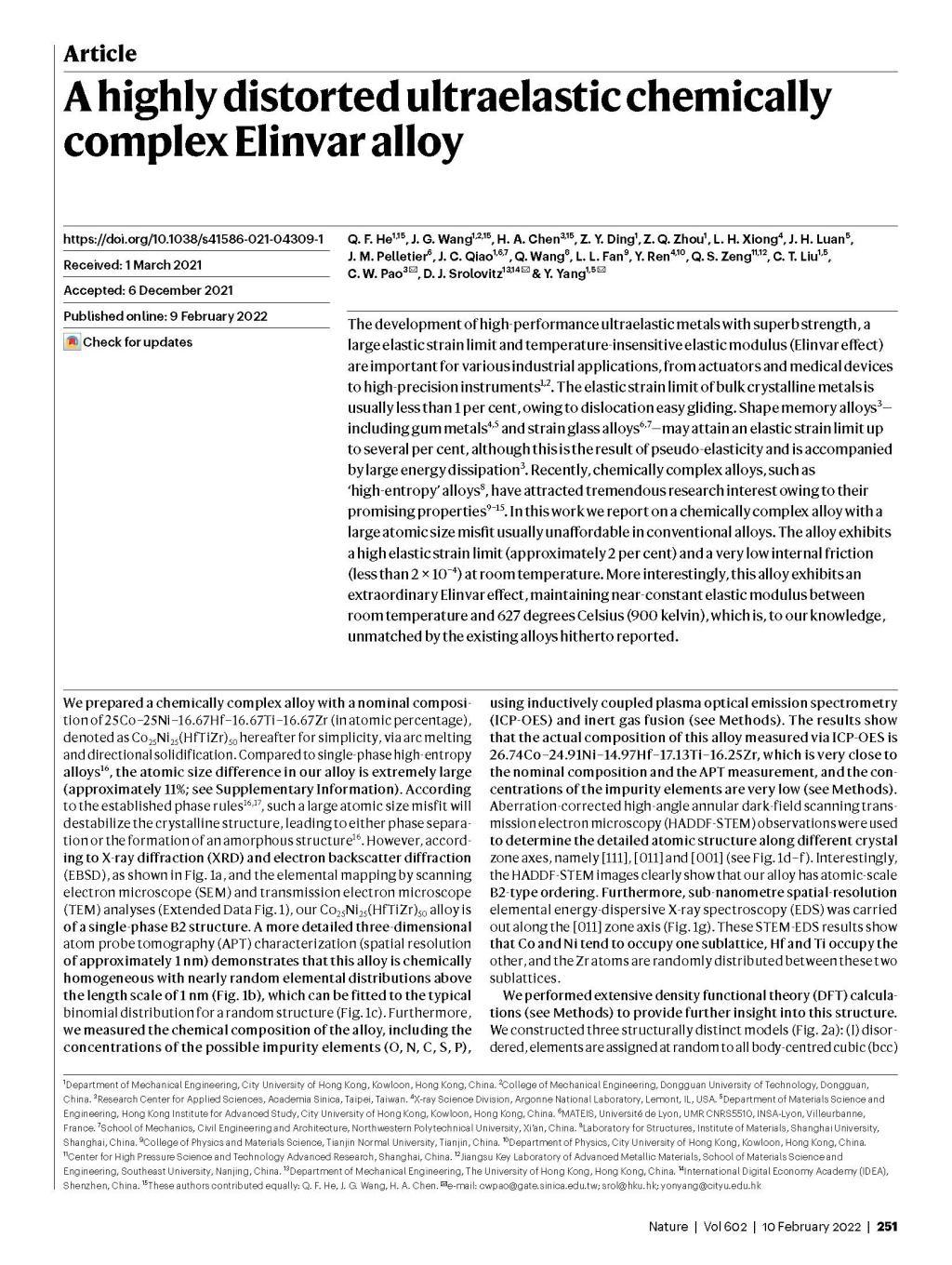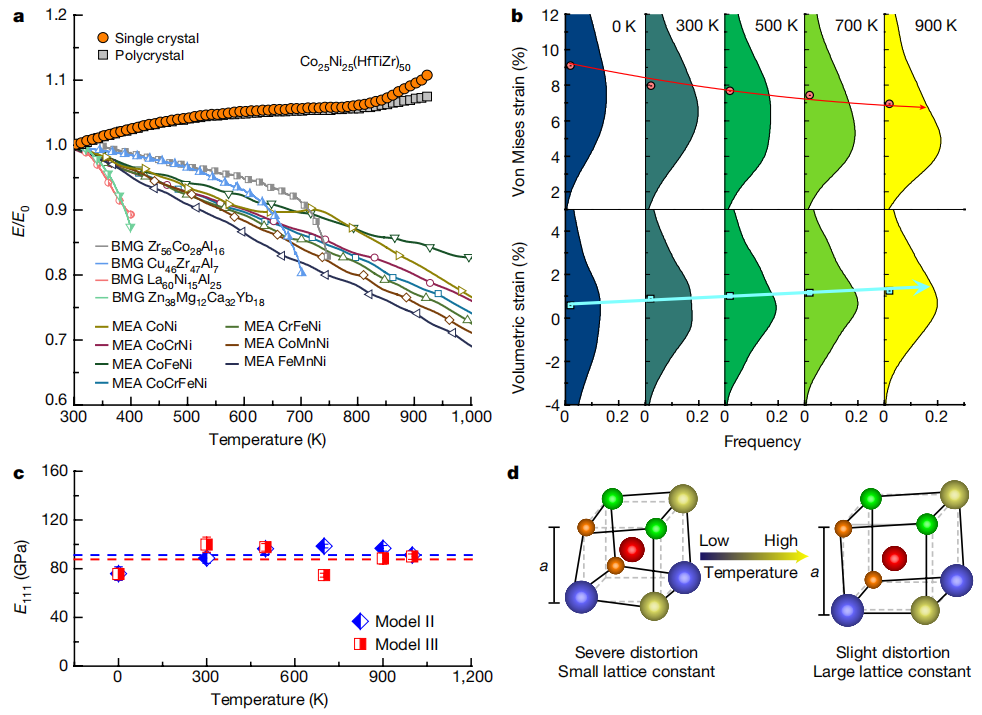近日,我校机械工程学院非晶合金成形制造工程研究中心王建国教授与香港城市大学杨勇教授团队等合作,在一种五元合金体系中发现了一种新的艾林瓦效应(Elinvar effect)的机制,为人们认识、研究和利用这类材料提供了一个全新的视角。2月9日,该项研究工作在线发表在国际顶级期刊《Nature》,王建国教授为共同一作,我校为第二完成单位。
Recently, Prof. Wang Jianguo from the Amorphous Alloy Forming and Manufacturing Engineering Research Center of the School of Mechanical Engineering, DGUT worked with Prof. Yang Yong and his team from City University of Hong Kong, and together, they discovered a new mechanism of Elinvar effect in a quinary alloy system. This provides a new perspective for people to understand, study, and use this kind of material. On February 9th, 2022, this research was published online in Nature, a top international journal, with Prof. Wang Jianguo as co-first author and DGUT as the second completion unit.

绝大部分材料的弹性模量会随着温度的上升而下降,也就是日常生活中人们熟知的“热软化”。但是有些材料的弹性模量在一定的温度范围内能够保持不变,甚至略微上升,这种现象以“弹性不变”(elasticity invariable)被命名为“艾林瓦”效应(elinvar effect)。瑞士物理学家查尔斯·爱德华·纪尧姆由于在艾林瓦合金方面的显著工作而获得1920年诺贝尔物理学奖。艾林瓦效应起源的微观物理机制有两种:相变和弹性各向异性。在一些合金体系中,沿着不同晶向弹性模量的温度系数有明显不同,而材料中大量晶粒的取向杂乱无章,因此彼此抵消,也会表现出艾林瓦效应。不过,这些材料中艾林瓦效应出现的温度区间通常较窄,一般小于100 K,因此材料使用的温度范围非常受限。
The elastic modulus of most materials decreases with increasing temperature; this is known as “thermal softening.” However, the elastic modulus of some materials remains the same or even rises slightly over a range of temperatures with invariable elasticity, and this is known as the “Elinvar effect.” Charles-Edouard Guillaume, a Swiss physicist, won the Nobel Prize in Physics in 1920 for his remarkable work on Elinvar alloy. There are two microphysical mechanisms for the origin of Elinvar effect—phase transition and elastic anisotropy. In some alloy systems, the temperature coefficients are significantly different along the elastic moduli of different crystal directions, and the disordered directions of a large number of grains in the material offset each other, resulting in the Elinvar effect. However, the temperature range at which the Elinvar effect occurs in those materials is narrow and is generally less than 100 K, hence, the temperature range for utilizing the materials is very limited.
研究人员在五元合金Co25Ni25(HfTiZr)50(at.%)中发现了艾林瓦效应,而且该合金中的艾林瓦效应有600 K左右的超宽温度范围,该合金体系不但显示了一种不同于以往人们所认识的任何一种艾林瓦效应的物理机制,而且也是一种截至目前艾林瓦效应存在温度范围最宽的新型合金。
The Elinvar effect has been found in the quinary alloy Co25Ni25 (HfTiZr) 50 (at.%), with an ultra-wide temperature range of about 600 K. This alloy system not only shows a physical mechanism different from any other Elinvar effect previously recognized, it is also a new alloy with the widest temperature range of the Elinvar effect so far.

由于存在严重晶格畸变,该合金的位错运动受到高能量势垒的阻碍进而表现出极高的弹性极限和非常低的能量耗散。由于超弹性和极端温度条件下的弹性模量稳定性,该合金可以应用于服役温度极宽的高精度设备中,如精密仪器、光电子器件、深空探测的等领域。
Due to the serious lattice distortion, the dislocation motion of the alloy is hindered by the high energy potential barrier and thus exhibits extremely high elastic limit and very low energy dissipation. Due to its super-elasticity and elastic modulus stability under extreme temperature conditions, the alloy can be used in high-precision equipment with an extremely broad range of service temperatures, such as precision instruments, optoelectronic devices, deep space exploration, and other fields.
该项工作受到国家自然科学基金委(52071081)、广东省科技厅(2019B030302010)和东莞理工学院(216112008)资助。
This research was supported by the National Natural Science Foundation of China (52071081), the Science and Technology Department of Guangdong Province (2019B030302010), and Dongguan University of Technology (216112008).
(论文原文链接:https://www.nature.com/articles/s41586-021-04309-1)
(Paper link: https://www.nature.com/articles/s41586-021-04309-1)